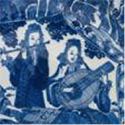|
|
| Show All 27 Results (Text Only) |
|
| How to Identify a Buddha |
|
| Asian Art Museum of San Francisco
|
"The earliest surviving representations of the Buddha date from hundreds of years after his death, so they are not portraits in the usual sense. Buddha images vary greatly from place to place and period to period, but they almost always show these conventional features..." Downloads includes student handouts and a teacher packet on Hindu Buddhist Art. See also An Introduction to Buddhism.
Go to Museum Resource: https://education.asianart.org/resources/how-to-identify-a-buddha/ | |
|
|
| Illuminated Manuscripts: The Sacred Art of Narration |
|
| Asian Art Museum of San Francisco
|
Students will: 1.) Identify the format and elements of a sutra. 2.) Examine why sutras (the teachings of the Buddha) are important historical and religious documents. 3.) Analyze why the writing of sutras is considered an important religious act. 4.) Construct and illustrate an accordion book manuscript based on the sutra format used during the Goryeo dynasty. Downloads include Visual Guides, a Lesson Plan, and Teachers Packet.
Go to Museum Resource: https://education.asianart.org/resources/illuminated-manuscripts-the-sacred-art... | |
|
|
| International Dunhuang Project: Silk Road Exhibition |
|
| The British Library
|
An extensive image archive featuring manuscripts, paintings, textiles, sculptures, murals, coins, and other artifacts from six Silk Road excavation sites: 1) Samarkand; 2) Khotan; 3) Kroraina; 4) Miran; 5) Dunhang; 6) Gaochang. Excellent descriptive text with most objects. Also includes maps, site diagrams, and some photographs.
Go to Museum Resource: http://idp.bl.uk/education/silk_road/index.a4d | |
|
|
|
|
| Luxury Arts of the Silk Route Empires |
|
| National Museum of Asian Art, Smithsonian Institution
|
"Two thousand years before today's "global economy," an exchange network linked the continent of Asia via the Silk Route. Between the first and eighth centuries of the common era, the empires and states of Asia often came into conflict as they competed for territory and other resources or sought to dominate their neighbors in religious and political arenas." A brief illustrated guide, focused mostly on metalwork and pottery.
Go to Museum Resource: https://asia.si.edu/exhibition/gallery-guide-luxury-arts-of-the-silk-route-empi... | |
|
|
| Mapping the Silk Road (interactive) |
|
| Asian Art Museum of San Francisco
|
Students analyze objects from South Asia, West Asia, and China to connect to the travel experiences of ancient merchants and traders, develop an understanding of the breadth of the land and sea trade, and explore how art and ideas travel and change over time and place.
Go to Museum Resource: https://education.asianart.org/resources/mapping-the-silk-road/ | |
|
|
| Monks and Merchants: Silk Road Treasures from Northwest China, Gansu and Ningxia, 4th-7th Century |
|
| Asia Society
|
Features more than 35 objects organized into the following topics: 1) Heavenly Horses; 2) Nomadic Rulers; 3) Buddhism and China; 4) Buddhist Cave Temples; 5) Bodhisattvas; 6) Monks; 7) Merchants and Currencies; 8) The Tang Dynasty. Each topic has overview text, and each object is accompanied by short descriptive text. An additional topic on the Silk Road itself gives extensive background information on the geographical, historical, religious, and cultural context of the Silk Road.
Go to Museum Resource: http://sites.asiasociety.org/arts/monksandmerchants/index.html | |
|
|
|
| Show All 27 Results (Text Only) |








